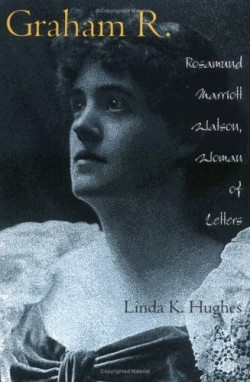Graham R.
Rosamund Marriott Watson Woman of Letters
The rediscovery of forgotten women writers leaps ahead with this biography of a woman whose life defied the idealized domesticity that confined late Victorian ladies. Like the Brontës, she initially published as a man, but her trajectory included two name changes, seven books, and many poems, book reviews, and magazine articles about art and fashion. The celebrity she enjoyed after revealing her sex enabled her to champion a woman’s right to write and live on her own terms.
Born in 1860 to a middle-class family in which “the only constant was ambition,” Rosamond Ball married George Francis Armytage at age twenty. After publishing Tares, her anonymous first book of poetry in 1884, she eloped with painter Arthur Tomson and forfeited rights to her two young daughters. Reinventing herself as Graham R., she became Arthur Tomson’s wife and the mother of Tommy, born merely eight days after his parents married.
Graham R. enjoyed considerable literary renown despite poetry that seems contrived and saccharine to today’s readers: “I would not watch another autumn fade, / Vext with shrill winds and stung with vain regret: / Be it mine to seek the inviolable shade, / And—maybe—to forget.” She contributed to the best periodicals of her day, published two volumes of verse, edited five more, and founded and edited the feminist-leaning periodical Sylvia’s Journal. Active in the Literary Ladies, a dinner club established by women writers excluded from prestigious male-only clubs, she was well known in a luminous circle that included Thomas Hardy, J. M. Barrie, Oscar Wilde, H. G. Wells, and Henry James. Then, seemingly against all common sense, she destroyed her Graham R. persona by eloping with the writer H. B. Marriott Watson in 1894.
Now Rosamund Marriott Watson, she published four books and debuted in The Yellow Book, Pall Mall Magazine, and New Liberal Review. The mother of a fourth child, she endured reduced financial circumstances and ostracism by former friends. It’s difficult to muster sympathy for these tribulations, however, because doing so trivializes the maternal loss experienced by her other three children. However, one need not like this prolific writer to appreciate her ambition, remarkable survival skills, and canny assessment of literary markets. Any tribute to noteworthy fin-de siècle women should include Marriott Watson, even though her second elopement and name change ultimately consigned her to literary obscurity.
The author’s other books include Victorian Publishing and Mrs. Gaskell’s Work, The Victorian Serial, and Strange Bedfellows: W. E. Henley and Feminist Fashion Theory. She has constructed here a compelling narrative of a notable life, despite the challenging limitation of having only public documents from which to work. Her insightful reconstruction overcomes the dearth of private letters and journals to give readers an intriguing glimpse into the professionalization of literary production in the decades before the modern period. (October*)*
Reviewed by
Elizabeth Breau
Disclosure: This article is not an endorsement, but a review. The publisher of this book provided free copies of the book to have their book reviewed by a professional reviewer. No fee was paid by the publisher for this review. Foreword Reviews only recommends books that we love. Foreword Magazine, Inc. is disclosing this in accordance with the Federal Trade Commission’s 16 CFR, Part 255.

